|
|
|
|||
|
|
||||
|
|
||||
| The (Jet)X Files | ||||
|
|
HOME | SITE MAP | FORUM | CONTACT |
|
||
|
ABOUT | MOTORS | MODELS | ARCHIVE | HISTORY | STORE | FAQ | LINKS
|
|
|
|
|
|
|||||||||||||||||||||||||||||||||||||||||||||||||||||||||||||||||||||
|
The (Jet)X Files 4
(April 2003)
by Roger Simmonds Reprinted from SAM 35 Speaks, April 2003 First, many thanks to all those who have welcomed the return of “Jetex topics” to SAM 35 Speaks, and asked questions, shared reminiscences and corrected my misconceptions. This feedback has made me realise that many folk do not know what Rapier rocket motors are, or their relation to Jetex motors, or where to buy them, as they have never seen them advertised in the ‘glossies’, (which they say they don’t buy anyway!). |
|
|||||||||||||||||||||||||||||||||||||||||||||||||||||||||||||||||||||
|
Rapiers are made in small batches by Jan Zigmund (right) in the Czech Republic. This is not a big operation like Estes (who are not interested in this type of motor), but is more a cottage industry, which is why one does not see advertisements for them. They were first available in the UK about four years ago, and can be obtained from The most popular motors (see ilustrations right) are the tiny L-1 (up to 8g thrust) the L-2 (about 11-14 g thrust, equivalent to a good Atom 35), and the L-2HP (about or 22g thrust, equivalent to a 50B). The motors are surprisingly light (about 7.5 g for the L-2) as the cap and nozzle are ceramic whilst the casing is a cardboard tube (49 cm long and 11 cm diameter for the L-2 and L-2HP, the L1 is slightly smaller). Generally, motors are mounted in paper tubes slightly forward of the traditional Jetex position. They are, like Jetex motors, ignited by fuse, but are replaced after their ‘one shot’ use. The propellant is more efficient than even Jetex ‘Red Spot’ pellets, and the exhaust is appreciably more energetic than Jetex efflux, being much hotter, a good deal dirtier, and it must be said, more toxic. Run times are about 17-18 sec. The popularity of these motors speaks for itself, and Rapiers are everything that Jetex should have been; they seem impermeable to moisture and misfires are rare, and the thrust is reproducible within batches and consistent throughout a run. A drawback is, as Stan Pearson (aka Funf) has pointed out, cost, but then eau de Cologne or Chanel No. 5, are also expensive, and Rapier exhaust smells better than either. Another respondent thought there would be a dearth of material for the column, but he reckoned without the internet. Now I had to be dragged into the computer age, and I became part of the ‘internet revolution’ very reluctantly. But there are compensations for all the pain, and many aeromodelling related web sites are really very good – in fact perusing these is a bit like getting the old Aeromodeller at least every week. There are also special interest groups, for example the Jetex.org Discussion Forum and For anyone interested in Jetex related topics, Jetex.org, which has good links to related sites, is an excellent place to start,. Particularly interesting for SAM members is the Jetex History section that readers might like to contribute to. It already has, amongst its extensive archives of Jetex memorabilia, a meticulous history of Wilmot, Mansour, & Co., copies of the “engine tests” of the original Jetex motors (Ron Warring, Aeromodeller, 1953 onwards), and many plans, including some from the Frank Zaic Yearbooks. These can be investigated more cheaply than by mail order, and hard copies can be made easily if one has the appropriate software access to a printer that can cope with paper larger than the usual A4. This may be a good time to search out some classic free flight designs in readiness for the new “Rapier 30” competition announced in the latest SAM 1066 newsletter, drawn to my attention by Graham Knight. Oxford MFC intend to run a new duration class for models no bigger than 30" span or length and Rapier motors no bigger than an L-2HP. There are five rounds and a 1.30 max. So it’s time to seek out plans for Arrows and Snowflakes, Fizzle Quicks and the like. Conversion of these to Rapier power, even if they were designed for the larger Jetex motors, is quite straightforward. A model of 30” span for the Jetmaster (which had about 40 g thrust) should be reduced in size by the cube root of 40/14 (about 1.4) for the Rapier L-2. If you make a 71-72% % photocopy of the plan this should be about right. Similarly, an Arrow 50 would be reduced to about 70% for the L-1. Remember though, that the thrust of Jetex units was variable and possibly over estimated for a well used motor. I have an original Keil Kraft Star-Jet designed for the PAA-Loader. This has a 28” span, but if built light it might go very well with the L-2HP. |

- Terry Kidd

- Ben Nead
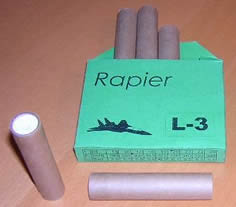
- Mike Stuart

- Ben Nead
 
- Howard Metcalfe
|
|||||||||||||||||||||||||||||||||||||||||||||||||||||||||||||||||||||
|
|
|
|||||
|
The majority of scale models, in contrast to duration models, were designed for the Jetex 50 and its derivatives. The principles of modifying these designs for the L-2 were covered in Aeromodeller, January 2001, and Model Flyer, March 2001 and I would refer readers to these issues. In the main, reduction in size to 90% of the original was advised, but extra spars can be added to the wing, the nose sheeted, and the trough deepened to hide the motor quite nicely. Now some models like the KK MiG 15 are quite large and can handle the extra power of the L-2HP, but Howard Metcalfe has pointed out that models designed for the original ribbed aluminium Jetex 50 (which had about 14-16 g thrust) were overpowered by the later 50B. This motor could, according to the Aeromodeller tests, deliver up to 24 g thrust at the end of its run and therefore reducing the size of many models for the L-2 may not be necessary if models are kept light, that is, below about 35 g. The Aerographics Bell XS-1 (right) was originally designed for the Powermax Jet-X 50, but it flies well, and is curiously stable, in a wide flat circle at 20-50 feet when powered by an L-2. It appears less predictable and becomes twitchy when powered by an L-2HP. Though small wings (with generous dihedral) and a long fuselage are seen today seen as one recipe for a successful model, getting the power/size relationship right is definitely an important key to a predictable flight pattern for these models. |
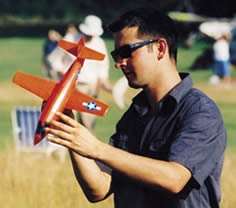 |
|||||
|
I was definitely confused in my February column about the set up of the Wilmot Mansour SARO A/1 (right). Alan Walker gently points out that if the model was trimmed slightly nose heavy with empty motors, with loaded motors the CG moved back for a powered climb, and the CG moves forward in flight for a safe (and swift) glide to earth. The CG is quite low vertically in this unusual design, so that the thrustline of the motors is actually through the CG. Whilst we are on the SARO A/1, Howard tells me that the rudder was attached to a “paddle” between the motors (see lower diagram, right), actuated by differential thrust, but he isn’t sure how it worked. All the same, this model cannot have been easy to trim. There is less agreement why small changes of the thrustline of a motor at or near the CG are effective. For some models the reaction of the exhaust with the trough acting as a deflector plate might be one factor, as could be the centre of drag in relation to the motor, but if I am puzzled, I am in good company. An article in Model Aircraft, March 1956 states, “A rocket motor is nearly always mounted near the CG and large angular settings are needed to produce the required trimming effect”. However, Graham Knight says that subtle effects can be achieved with small angles of down thrust and side thrust, so that trim tabs and other abominations need not desecrate our models, and I for one believe him. It may be that with the absence of Jetex for many years we have forgotten the subtleties of trimming small rocket planes. Trimming of some models (such as the Aerographics XS-1) is quite straightforward. However, a consideration with more difficult swept wing subjects is that some established Jetex strategies, such as using only one or even half a pellet for first flights, or opening up the jet orifice (not recommended with Rapiers) are not available. It is feasible to trim a model designed for L-2 power initially with an L-1, and others suggest leaving Rapiers out in a damp atmosphere, but the effect of moisture absorption on thrust is not predictable. Phil Smith, talking about ‘Jetex Powered Flying Scale Models’, said, “all trimming was subject to the variation of thrust, burn rate, loss of power between pellets, etc”. These effects are largely absent within Rapier batches so that ‘exploring the flight envelope’ of models can proceed quickly, if disappointingly, knowing that the motors are a constant factor. Be aware, though, that the next batch of the same motor can give a different thrust and duration (these are indicated on the box). It may be necessary, after trimming a model for L-2 motors with say 11 g thrust, to have to start gain with a new batch that gives 14 g thrust, as these are the only ones currently available. This is annoying, and it is worth building some moveable control surfaces into your model for this reason alone.
|
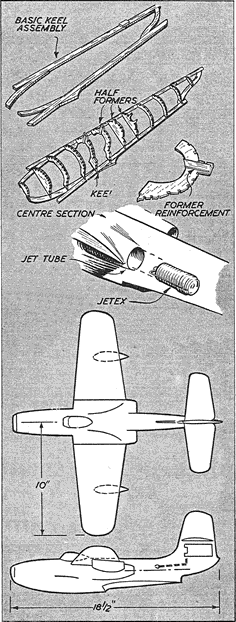 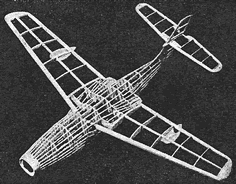 Jetex SARO A/1 – diagram shows rudder linkage and photo shows MA review model under construction
- Model Aircraft, Jan. 1953 (p. 27)
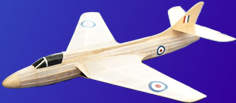
- Andy Blackwell
|
|||||
If trimming models with a single Jetex motor was difficult, given that the “models have “little or no inherent stability” (
To quote Paul Del Gatto in |
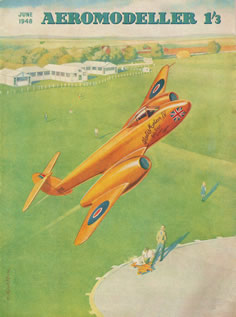
- Aeromodeller, June 1948
|
|||||
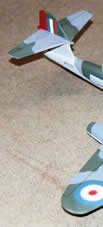
In the last column I sought to justify writing about new plans and models. We have to modify period designs for new motors anyway, and the creation of own designs, stimulated by an informed appreciation of old designs, is a natural extension of this. The discussion was, I admit, partly to alleviate my own conscience so I could remain a committed, and I use the word advisedly, SAM member whilst attempting to design and build models of some of the more obscure jets of the fifties. Making small models for rockets calls upon traditional building and flying skills, and it is this that makes it such a comfortable part of the SAM umbrella. If you want your enthusiasm for small jet planes reinforced, a visit to www.ffscale.co.uk will do this and more. Websites like this, and there are others, make all the trauma of getting wired (I think that is the barbaric expression) seem worthwhile. Until, that is, the next |
|
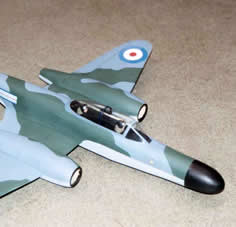
- Chris Strachan
|
||||
|
|
||||||
|
|
|
|||||
|
|
|
|
|
|
|
|
Acknowledgements - Article: Roger Simmonds - Illustrations: Roger Simmonds, Peter Blackmore, Andy Blackwell, Terry Kidd, MAAC archives via Bill Henderson, Howard Metcalfe, Ben Nead, Chris Strachan, Mike Stuart |
|
|
|
|
ABOUT | MOTORS | MODELS | ARCHIVE | HISTORY | STORE | FAQ | LINKS |
|
|
Terms of Use
|
Queries? Corrections? Additions?
Please
contact us.
|
|